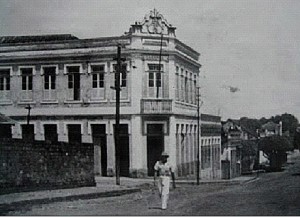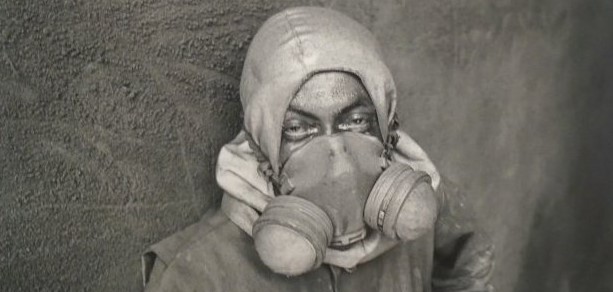Lebanese in the Brazilian National Market
This article is written by John Tofik Karam who was a core faculty member in the Latin American and Latino Studies program at DePaul University in Chicago at the time of this writing. He now works as Director of the Lemann Center for Brazilian Studies at the University of Illinois Urbana-Champaign. His research and teaching interests are ethnicity, nationalism, globalization, Brazil and what he calls “the Arab Americas.” His book, Another Arabesque: Syrian-Lebanese Ethnicity in Neoliberal Brazil, won the 2008 Arab American National Museum Book Award in the non-fiction category as well as the 2008 Brazilian Studies Association’s Roberto Reis Award.

Images of commercially-astute Lebanese have appeared and reappeared in Brazilian popular culture for more than a century. In the 1920s, the writer Cornélio Pires featured money-haggling Middle Eastern peddlers, and these so-called turcos (Turks) made their debut in São Paulo’s popular theatre by the 1930s. In Rio de Janeiro in 1945, the poet Carlos Drummond de Andrade rhymed: “The turcos were born to sell/ colorful knickknacks in canisters/ door-to-door./ … If they open the canister, who resists/ the impulse to buy?/ It’s cheap! Cheap! Buy now!/ Pay later! But buy!” From the 1950s onward, Lebanese peddlers roamed Jorge Amado’s novels set in Bahia, and from the 1970s to 1990s, these archetypes as well as Amado’s novels themselves were made into telenovelas (television melodramas) and mainstream films. Arabs’ presence across these imagined Brazilian landscapes speak to their settlement in four parts of the country: São Paulo, Rio de Janeiro, the Greater Amazon, and Paraná. Hawking wares on roads and rivers, Lebanese reveal the uneven making of the contemporary Brazilian market. In the state of São Paulo, the arrival of Syrians, Lebanese and Palestinians is linked to the departure of coffee exports to the United States and Europe. Although Arabs generally avoided actual work in agriculture, they peddled goods to both farm hands and farmsteaders. In 1895, Arabs already accounted for ninety percent of the peddlers listed in the almanac of São Paulo. One of the most famous was Benjamin Jafet, who ventured into the state’s interior to peddle thread, needle, fabric and other wares around 1887. Later Jafet and his brothers established one of the largest textile industries of the country in the neighborhood of Ipiranga in the state’s capital. Two other pioneers, Assad Abdalla Salem and Najib Salem, opened a retail store on the Rua 25 de Março, in the city center of São Paulo, around 1890.

Jafet, Abdalla, and Salem supplied fabric and haberdashery to countrymen who peddled them in urban and rural peripheries. Until 1930, many of these peddlers had become shopowners and dominated the wholesale sector in the textile industry. In the following decades, the hundreds of such businesses on Rua 25 de Março accounted for about half of the wholesale profits in the Brazilian textile sector. By the mid-twentieth century, Arabs also came to own more than a quarter of the spinning and weaving industries of cotton, silk, rayon, wool. and linen in the state of São Paulo. Occupying different branches of the textile industry, these patrícios, or countrymen, developed a chain of production and distribution from fabric wholesalers to garment retailers. Arabs stitched together a textile chain through the novel industrial, protectionist policies instituted by Brazil’s then president, Getúlio Vargas. This Lebanese pattern is also woven into Rio de Janeiro’s urban economy. Just as their counterparts in São Paulo settled on Rua 25 de Março because of its proximity to a railway, the first Syrian and Lebanese in downtown Rio de Janeiro settled on the Rua da Alfândega, just east of Tiradentes Square, due to its location close to a railway and port. There they set up an entrepot that supplied countrymen who peddled goods in urban and rural areas. Filling his baú or trunk, at dawn before leaving “toward the farms,” Tanus Jorge Bastani sold “socks … line … cotton, trinkets … rings, medallions and fancy bracelets, needles, combs, soap and a multitude of other objects … .” Until 1930, peddlers such as Bastani became tenants on the Rua da Alfândega, and in the following decades, dominated the wholesale market of fabrics and haberdashery.
In 1962, many of these retailers of Lebanese and Syrian origin came together to found an association called SAARA, the “Society of Friends on the Adjacencies of the Rua da Alfândega.” Its founder, Demetrius Charl Habib, started it as a way to mobilize shopkeepers against an urban renewal plan that would have cut the street in half. In 1970, his patrícios in São Paulo also established UNIVINCO, the “Union of Tenants of Rua 25 de Março, “to defend our interests with the government,” in the words of one of its Syrian leaders. In the late twentieth century, statues honoring the figure of the Arab peddler were erected in these two urban market spaces, the “Mascate” (Peddler) in the region of SAARA in Rio de Janeiro and the Phoenician-adorned “Syrian-Lebanese friendsdhip” on Rua 25 de Março in São Paulo. Starting in the late nineteenth century, Lebanese in the Greater Amazon peddled around the then dominant rubber economy and supposedly “reached all the banks of the Amazon River” by the first decade of the twentieth century. As foreign firms exported rubber to North America and Europe, many Lebanese businesses grew as part of the incipient consumer market. After the price of rubber plummeted in the 1920s, a handful of Lebanese-Brazilians took over such firms. Others concentrated on the trade across the Brazilian-Bolivian border, and after its inauguration in 1957, others opened businesses in the Manaus Free Trade Zone (ZFM).

As part of this landscape, the parents of my maternal grandmother arrived in Porto Velho, in the then territory of Rondonia on Brazil’s border with Bolivia. Known as Abdo Bichara Ghosn in Lebanon, and Abidão Bichara in Brazil, this great-grandfather of mine recruited two of his brother-in-laws from the Abouchabki family. Bichara sent them southward on the Madeira River to the then villages of Abuna and Guajará-Mirim, respectively. After receiving merchandise he ordered from the Amazonian cities of Belém or Manaus, Bichara would pass on some of them to the Abouchabkis, while keeping the rest in a two-story building he had built in the center of Porto Velho. According to a great-uncle, Bichara ordered large supplies near the end of the rainy season, and stored much of them in the warehouse. Weeks after the onset of the dry season when stocks thinned out in other stores, Bichara put his merchandise on sale at a higher price. He might not have called it the “law of supply and demand,” but Bichara never needed to write down the debts of his customers that he memorized.

These exchanges across the Brazil-Bolivia border in the Greater Amazon in the early twentieth century mirror Lebanese trade on the western edge of the state of Paraná during the second half of the century. Though they probably crossed this trinational border where Argentina, Brazil, and Paraguay meet since the late nineteenth century, Lebanese only settled there permanently in 1951. The pioneers were from two neighboring cities in the Bekaa Valley in Lebanon, Balloul and Lala, part of a migrant network extending from northern Canada to southern Argentina. After having pedddled along the rivers for mostly Brazilian customers in Foz do Iguaçu and Paraguayan customers in Ciudad Presidente Stroessner (renamed Ciudad del Este after 1989), patricians of the Barakat and Rahal families opened their first stores in this border zone that at that time lacked retail clothing, dry goods, and other national manufactures. In the 1970s and 1980s, with the continuous arrival of migrants from the Bekaa Valley and South Lebanon, Lebanese came to dominate the booming trade in the neighborhoods of Jardim Jupira and Vila Portes, located near the Friendship Bridge that links Foz do Iguaçu to Ciudad del Este over the Paraná River. They exported Brazilian-made clothing, home appliances, and other products to Paraguay. Brazilian state tax incentives increased their profit margins, and decreased the price for customers. Mostly Lebanese represented the majority of the 600 of such companies. The Mercosul trade bloc that went into effect in 1995 dealt a severe blow, and today there survives only a fraction. Still, their story shows that while Lebanese in São Paulo, Rio de Janeiro, and the Greater Amazon opened their businesses in the shadow of northern economic power, Lebanese in Foz do Iguaçu marked the rise of Brazil as a regional power today.
- Categories:


